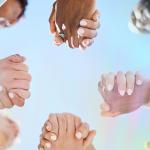<updated 3/20/2020>
I believe crises carry the seeds of opportunity if we approach them in the right way, which means clearly understanding the facts and strategizing a response that helps us emerge stronger and wiser on the other side.
Extensive research into the coronavirus pandemic leads me to conclude that the time is NOW to implement strong social distancing and protective measures to minimize the pandemic. Not tomorrow. Today.
It’s time to stop public gatherings everywhere we can so that we can slow the spread and gear up our emergency preparedness, as well as identify the large number of people already infected. Every day we wait will cost lives. I am heartened that California, New York, Illinois and other states are now requiring people to stay home.
For a sophisticated analysis of why immediate action is required everywhere, read “Coronavirus: Why You Must Act Now” from a Silicon Valley exec who crunched a lot of numbers and concluded we need to implement measures like the Chinese did without delay.
Below is more of a layman’s guide to understand and navigate what is upon us, with a focus on positive actions you can take.
The Big Picture
The first thing to address is why such apparently extreme measures are happening so quickly for what seems to be a relatively small number of infected people so far.
Basically, Covid-19 is a novel, highly contagious virus that spreads 2–4 times as rapidly as the flu, has a long incubation period of up to 14 days, and can be transmitted by people with mild and even no symptoms. It can survive for several days on surfaces, perhaps up to 9 as well. All of which make it very, very tough to contain.
It’s also more deadly than a regular flu by a long shot, particularly for the elderly and the health-impaired. It has been killing 3.4% of those we know are infected but that could be an overestimate based upon the low testing frequency. South Korea has a death rate of .89% currently and has the highest rate of testing but still a lot of patients who are not out of the woods, as well as a younger population. So in the best case scenario, the death rate could end up in the .8–1% range, at least in situations where there is excellent testing and advanced medical care, which is unlikely as this pandemic progresses.
Thomas Pueyo’s article offers a well-grounded analysis that shows that in places where the medical system becomes overwhelmed, the death rate trends towards 3–5%, or up to 5x what happens when things are kept contained. In Italy, which has an excellent medical system, we’re seeing triage situations where they have to choose who they let die because of lack of equipment (source). Their death rate was 6% and is going up over 8% and it is clear they have not hit the pandemic peak yet.
Even the highly optimistic end of the mortality range would be 8-10x a typical flu death rate, and the bad end is more like 30–50x.
The one piece of good news is that it seems to be mostly sparing children. Data from China show a death rate of only 1 in 10,000 children vs. 1 in 7 elders over 80. The death rate is still only 1 in 200 for people 40–49. Here’s a chart by age. So it is more for the sake of our elders and those who are health compromised that we need to take immediate and smart actions, not based on fear but on a reasoned assessment of what is coming. There are now an increasing number of severely affected young adults as well.
The rate of growth in infections outside of China has been accelerating from 2x every six days to as fast as 2x every two days. It is varying some by country and availability of testing. This range of rates puts us on the trajectory for at least millions of global cases by April, at least tens of millions if not hundreds of millions by May. This chart shows the trajectory outside of China, which tells the story visually. The California governor shared their projection that 56% of Californians would be infected within an 8 week period without further intervention.
Some epidemiologists are estimating 40–70% of the world’s population is likely to get it before we are done, which is echoed by Chancellor Merkel’s statement that up to 70% of Germans could get it. Run those numbers and even at 40% of 7.7B people at a best-case .8% mortality rate, we end up with 25M deaths worldwide. If you boost the mortality rate to 2%, which many believe is more accurate, deaths more than double. And if we end up with a worst-case scenario with medical systems melting down, a 5% death rate globally could put us in 150M death terrain. For comparison, total deaths attributed to World War II are 70–85M — and that’s over multiple years.
If things progress as rapidly as they are right now, we will overwhelm most of the medical systems on the planet very fast and the death rate will increase not only from running out of equipment for coronavirus treatment but compromised treatment for other diseases. Around 10% of known cases so far in places like Italy are requiring hospitalization, and in China the average stay has been 28 days, which means an enormous hospital load in an already stretched system, not even counting the health care workers who will have to stay at home to take care of kids out of school.
Our main, urgent focus as a civilization thus HAS to be to immediately take actions to slow the spread so that the peak of the pandemic hits far enough out that we minimize the overwhelm of medical services. The slower the build to the peak, the better we can hope to weather this and the fewer who will die. That is what people mean by “flatten the curve,” which is depicted visually here. Regardless of our personal risk of death or hospitalization, we need to participate in slowing the spread for the good of our entire community.
It’s our civic duty to our community and our moral duty to our elders and the sick among us to delay the spread as long as we can. We need to do extreme social distancing and personal quarantine even before we have to,.
Read this article from an Italian doctor if you doubt this or feel that if you are young, you will be fine.
Right now, we have 2.8 hospital beds per 1000 people in the United States, of which perhaps 1/3 are currently unused. Even with temporary tents and conversions of other rooms, we’ll be hard-pressed to more than double that, particularly given the limitations of equipment like ventilators (160,000 in the US) and trained staff. As the size of the outbreak grows, the quality of medical care available will diminish along with the staff available to handle the load as schools close. Supplies will run short quickly on everything from masks (only 12 million N95 masks right now for 8 million health workers, about 1% of what is needed in a full-blown pandemic) to protective gowns. With global supply chains disrupted, medical supply shortages will become even more acute.
In the United States, by my estimates, we’ll need to aim for a maximum peak of infections somewhere in the range of 1–10 million (depending on whether we can lower the percent requiring hospitalization and create more bed space fast enough, as they had to do in China) or the medical system will overload. We are currently headed for those numbers much sooner than you might imagine based on Pueyo’s analysis.
If we are able to stretch out the peak closer to a year, which would be an almost miraculous success, or do a mass lock down intervention fast enough, the United States medical system might be able to just barely handle the load. The longer we stretch out the time before the peak, the more time we have to manufacture medical supplies, build temporary structures, convert buildings for bed space, etc. There are also some promising treatments that may come online as well to mitigate things. But if we assume a vaccine arrives in Q1 of 2021, which is the best case scenario unless a drug treatment arrives sooner, we could just barely weather the worst.
To get to that “rosy” scenario, we’re going to have extreme containment measures resembling what China did (read this NY Times article about their innovations that led to success). And it’s going to be happening ASAP everywhere in the world because the more the virus spreads without testing and detection, the quicker we’re going to hit the peak and face massive health system overwhelm. There’s really no choice but for governments around the world, who are tasked with protecting their population, to enact measures that lead to full lock down of each country.
These are not overreactions but necessary given the risks of delay. Every day will see more and I am grateful for the leaders who have boldly moved forward with full societal shutdowns.
Expect all the social distancing practices to come to every corner of the world. Basically, we’re going to have to grind much of our social interaction to a halt almost immediately in order to slow the spread enough to prevent catastrophic overwhelm of the medical system in particular. That will also help us to catch up with the urgent needs for testing.
To be part of the solution, the time for you to do this is NOW, even before you are required to.
Without massive, rapid intervention, we will escalate to a very high pandemic peak that might be 5–10x the number medical patients our system can handle leading a much higher percentage to die. Globally, that could mean 50–100M additional deaths if we peak fast vs. peak slower.
The other option is what Pueyo calls The Hammer approach, which is to do the most drastic interventions fast for 3–8 weeks and then have a Dance for the following 12–18 months. This is a suppression strategy and really is our best bet rather than mitigation, which results in tens of millions of global deaths.
However fast governments are able to get us to lockdown, we’ll mostly be spending the vast majority of our time at home for at least the next few months and possibly as much as a year and need to be very, very cautious in public settings to minimize transmission. This will have huge repercussions on families, businesses, and community life.
The challenges with much of the rest of the world emulating China is that they are a more centralized, monitored, and organized society that can move fast. They had a singular outbreak location that could be quarantined with an all-out mobilization of the rest of the country. South Korea was similar, with one primary location and rapid intervention combined with widespread testing. We can replicate this strategy but the virus is already widespread almost every country as well as all 50 states in America. Governments vary widely in their size, control, and ability to do what worked in China — and in many places, it could be too late to be 100% effective. So that even if one country is successful, we will be prone to waves of reintroduction, unless every nation guards its border completely with total travel bans, which are hard to enact in places such as Europe or across the United States; plus, such moves will also paralyze the global supply chain.
What we really need is for every government of the world to come together to effectively shut the world down for at least 30 days at the same level China did, regardless of how many cases each country currently has, all while we implemented the scale of massive free testing that South Korea has done. Such a Global Shutdown for 30 Days (#GlobalShutdownfor30Days) would probably need to exclude China, which has effectively done this already since we would need someone to manufacture the medical supplies, tests, and essentials for the rest of the world while it stops. South Korea and Taiwan (source) might be exempted as well if they have won their battle completely since they can also isolate more easily. The goal of such a campaign would be to shut down all non-essential commerce, travel, and social activity on the planet except medical care, food and emergency services at the same time so we could pass a planetary pandemic peak and get it under control at the same time. It would be unprecedented but give us the best likelihood of slowing the spread and give our medical systems enough time to test and treat all those who are affected without overwhelming medical systems. China showed it can be done with 1.2 billion people and we can show it can be done with the other 6.5 billion.
In lieu of this coordinated global solution, which will require all political leaders to collaborate, each country will individually move to shut their borders, curtail social engagements, and halt travel and non-essential work as the pandemic ramps up in their country. But unless one is an island, a boundaried peninsula (like South Korea), or a tightly guarded nation (like China), it will be very difficult to avoid reintroduction of the virus even from nations that fail to keep it contained within their borders. With a vaccine at least a year a way, it turns into a long battle on many fronts.
What To Do
While the above facts are very grim and daunting at first, it’s important not to panic or go into overwhelm for the simple reason that fear leads us to behave irrationally, increase stress, and depress our overall system health.
The first priority is to immediately start social distancing practices:
- Stay at home and cancel all social engagements and travel.
- Greet with elbow bumps, bows, or namastes if you do see people.
- Avoid all small, medium, or large groups and areas where people congregate.
- Stay completely isolated if you have symptoms of any sickness at all.
- Apply the hygiene and social isolation principles recommended by the CDC.
Second, prepare yourself on a logistical level if you still can with:
- A 14-day minimum supply of non-perishable foods.
- Bulk medicines for anything you need over the next six months if possible.
- Stocks of everything from propane canisters to critical supplies.
- As much cash reserve as possible for the potential economic shocks. If you don’t have any reserves, see if you have allies who might backstop you. Get on Venmo or Paypal so you can pay people virtually for services vs. cash.
- NOTE: It’s imperative you do not hoard medical supplies (like N95 masks) that will be needed by the system. Most of the interventions we need individually are low-tech.
Third, prepare your emotional and community support network:
- Talk with your family and get everyone on the same page, discuss roles, opportunities, and needs as this unfolds.
- Get to know your neighbors and convene conference calls to discuss where there are resources that can be shared or optimized, especially if critical pieces of your own infrastructure break. Make sure to have phone and email contacts for people.
- Families with children may need to either isolate or create shared clusters of a few families that share the load of parenting and homeschooling. Small clusters of 2–3 families will be easier to minimize the viral exposure and collaborate on strong self-protection protocols.
- Elderly or sick people will need to identify people, ideally young adults, who can shop for them, run errands, and handle things that might bring them into contact with infected people. Think of this as a kind of buddy system that can also provide some social exchange and some employment for the youth who are likely going to face financial hardship.
- Determine who is going to feel the most isolated in your network and make a plan for regular Skype or Facetime calls to check up on them.
- Identify people who are most likely to be most at risk from the economic impacts and see what you can do to help them weather what is coming. Seattle offers a great example of pooling resources for those most in need.
- Get on social platforms that connect you with neighbors, allies, and good information and resource sharing (Zoom, Facebook, Time Banking, etc.)
The fourth imperative for a positive outlook moving forward is that you need to optimize your own psychological and physical health to boost your immunity and your resilience. You want to enter this coming period as strong as possible. The most basic recommendations for self-care:
- Sleep at least 8 hours every night. More if you can.
- Get regular exercise in your house or outdoors.
- Eat a balanced and healthy diet with good hydration.
- Meditate or pray daily to focus your mind and uplift your consciousness. Double down on spiritual practices.
- Work with fears as they arise but don’t let them overwhelm you.
- Focus on opportunities, not doomsday scenarios: how can this situation cause positive changes that we and the world need anyway? This keeps us out of the more hopeless victim mentality, which is bad for our health.
The basic principle here is that for you to be a positive example and support to others, you need to double down on practices of self-care so that you can uplift people who are going to be experiencing fear, anxiety, and scarcity.
Fifth, start looking for the opportunities of what you can do at home, which helps so you don’t feel bored and anxious:
- Take up a hobby you have long wanted to do or projects around the house
- Gardening has the benefit of providing fresh vegetables for the family and creating more local resilience the deeper into this we get.
- Have you wanted to write a book? Start a blog? A podcast? This will be a good time to express your creativity.
- Take your cooking abilities to the next level.
- Take more online courses. Work on a virtual degree.
- Think of ways that you can monetize your skills, like coaching others via Zoom or Skype. Get entrepreneurial as there may be new opportunities to serve real needs in a way that generates income for your family as well.
- Learn new computer programs and skills, from video editing to website design.
- Create a book club online with friends and do a video call every week to share what you’re reading. Create a reading list that will grow you in the months ahead — and you’ll actually have time to do it.
- Get recommendations from all the friends you trust for the “hidden gem” movies that you might have missed.
- Take time in more contemplative retreat if your commitments allow.
- Have deeper, longer conversations with people you have let drop away in your life. Renew your social connections virtually.
- Deepen your relationships with your loved ones.
Sixth, get involved in improve-the-world opportunities that this extended break from business-as-usual will provide. The more you focus on the opportunities, the more you unleash your creativity and focus on the positives. Some things that the pandemic may push us into that will help us in the long haul:
- Creation of stronger and more resilient local networks, which prepare us for other disasters as well as giving us more connections in our community.
- Virtualization of work. Telecommuting will force more people to get creative in how we engage our work so we can spend less of our time commuting in the future. This will help to reduce our carbon footprint, an important factor in addressing climate change.
- Source more food and energy locally.
- Reduce dependency on the global supply chain so we don’t buy nearly as many goods that are made on the other side of the planet.
- Shift from over-consumption to a more experiential and relational life.
- Deepen your growth practices and your ability to be calm in a tempest. This cultivates your capacity for more conscious leadership.
- Identify emerging leaders in the community who can be nominated or recruited into future political roles, raising the caliber of our political leadership on the other side.
- Focus on what unites us rather than what divides us, even in a contentious election season (which will move online). The pandemic can help us to cross political divides as we work on shared solutions to community challenges.
- Cross-generational collaboration: Since this will strike elderly populations hardest and the youth the least, it can activate more cross-generational relationships, which can prepare us to address other societal issues as well.
- New kinds of entrepreneurial ideas and visionary solutions will emerge. New businesses will be born. Necessity is the Mother of Invention and crises force innovative thinking. What could you incubate in this time of crisis that will demonstrate lasting value in the time after?
- A shift into the recognition that we truly are one interconnected human family now and that we can only solve our challenges when we work together. In essence, this crisis can propel us into more global solidarity. Our collective grief for those we lose will also bind us together.
The best case scenario is ultimately for us to approach this global pandemic as something that calls us into a higher level of collaboration, creativity, and conscious living. We can emerge living more sustainably, peacefully, and enjoyably with our local communities. We can develop more skills for independent lifestyles. We can cultivate a higher-quality, less-expensive lifestyle with less stuff.
We can remember who we are and our true purpose, which is to ultimately to leave our planet better for the next generation. Sometimes it takes a tragedy to wake us up. The coronavirus pandemic can be a wake-up call in multiple ways if we face the facts soberly and move into immediate right action to mitigate the damage and optimize the long-term upside.
If we all get active in educating others and making sure they are prepared as well as lobbying our elected officials to take dramatic actions as fast as possible, we can lower and flatten the pandemic peak to minimize the deaths or implement the Hammer to suppress the pandemic more broadly.
Let’s do our best to write the story of 2020 as a year not defined by a global tragedy but as a challenging but ultimately successful birth of a new way of being. Just as the toughest life experiences can catalyze our greatest personal growth, so can this planetary emergency lead to real growth of our species.
Other Resource Sites:
Flatten the Curve
WorldoMeters.info to track cases and locations
Epidemiology site with accurate numbers broken down geographically





